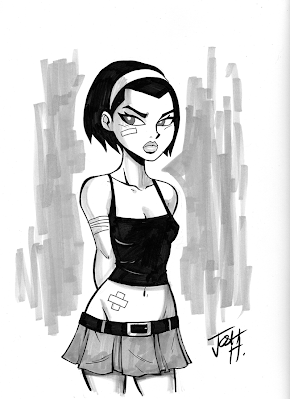Starring: Robert Cummings, Priscilla Lane, Otto Kruger, Alan Baxter and Normal Lloyd
Director: Alfred Hitchcock
Rating: Eight of Ten Stars
A factory worker (Cummings) is wrongfully accused of an act of sabotage at an aircraft assembly plant that claimed the life of his best friend. When no one believes that he saw the real saboteur (Lloyd), he sets out to follow the only lead he has to clear his name before the police can catch him. His investigation and deseperate flight takes him clear across the United States and brings him face-to-face with Nazi agents at the very top of American society.

"Saboteur" was Alfred Hitchcock's first all-American production, and for anyone who has watched his British pictures from the 1930s there are a number of elements that will seem awfully familiar.
Like in "Young and Innocent," the hero in this picture must locate a man that only he knows to exist in order to clear his name. Like in "The 39 Steps," the destructive agents of a foreign, fascist power are hiding behind the veneer of wealth and respectability. And like in both movies, the hero has to rely on the assistance of a young lady (here played by Priscilla Lane) who believes him guilty and is initially trying to see that he gets captured by the authories.
While the three films share similar elements, they are utilized more effectively here, almost as if Hitchcock recognized what was best about those two previous movies and refined those aspects for use here. The pace is brisker and the tension is far higher throughout, until the end where the final few minutes are slightly mishandled.
Basically, our hero is cleared of all suspicion well before the film's famous show piece encounter high atop the Statue of Liberty. I suspect the logic Hitchcock and his screenwriters were using when they decided to put the hero in a position where he would have to save the life of the man who ruined his (and who wanted to ruin the whole country) was that they would underscore his basic decency, However, that climax would have been far more suspenseful if he had to save him or never see his name cleared.

But, letting the factory worker be heroic for the sake of being heroic and for plain respect for another human being's life fits with a theme that runs through the whole movie.
The most fascinating aspect of the film is the portrayal of the common American versus our country's elite. Throughout the film, the fugitive meets and is helped by everyday Americans who are more than willing to lend a hand to someone in trouble., even if it means risk to themselves. But whenever he encounters the rich, powerful or famous, they are either traitors who want to destroy the country they should be thanking for their good fortune, or they are dupes of those who want to destroy the country. Even the film's heroine falls into this category, as she starts the movie out as a typical celebretard who believes herself to be patriotic but who doesn't realize that "her people" are harboring enemies of America.
It seems either very little has changed since 1942, as America's elite still seems to be the place where those with the strongest hate for America and deepest love for its enemies can be found. How many rich and powerful and famous Americans are merely too stupid to see they are pawns of those who want to see America torn down once and for all instead of being actual evil and ungrateful traitors? Are Sean Penn and Danny Glover merely stupid, or are they Fifth Columnists on the magnitude of the villains at the top of the organizations in this film, just lacking in the logistical support from their buddies in Venezuela and Iran to fully bring their dreams to fruition? I hope we'll never know, but I would still wish fewer of American's elite would devote so much time and energy to tearing the country down.
This aspect of "Saboteur" makes it a film that still has something to offer modern audiences even beyond its expert pacing and well-orchestrated final confrontation on the Statue of Liberty (even if it could have been better with a slightly different structure to the overall ending).




























.jpg)
